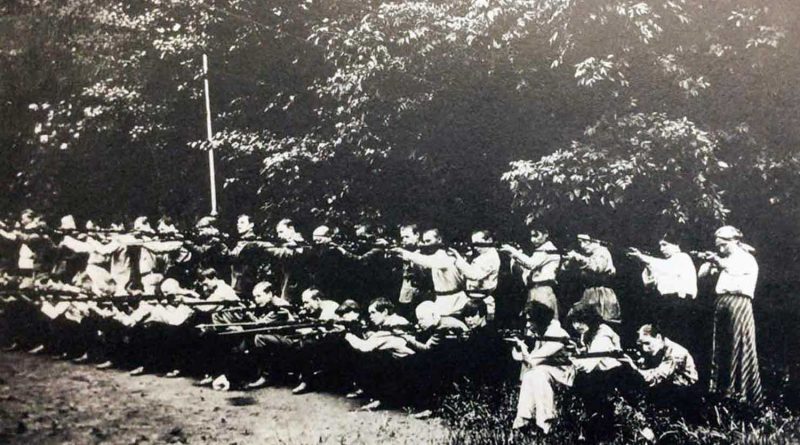The Suffragette People’s Army of Victoria Park
Nowadays Victoria Park is filled with peaceful picnickers and jolly joggers but, in a not too distant past, it was a training ground for a female-led armed militia. On 4 November 1913, the People’s Army had its first paramilitary assembly and gun drill in Victoria Park, led by suffragette Sylvia Pankhurst.
The People’s Army was a movement within a movement, born out of the need for the Suffragettes to adopt a more direct approach after police repression threatened to strangle the cause.
By early 1913, the Suffragettes had seen their attempts at obtaining “the vote” knocked back three times by parliament not passing it.
Although pressure was mounting on the government by that time, there was still staunch opposition to women being able to cast their votes in general elections. Feeling that ‘words had failed’, the Suffragette movement, spearheaded by Sylvia Pankhurst who ran the East London Federation of Suffragettes, began to use violence as their political voice.
As the Suffragettes began to use more radical tactics on their quest to change democracy – the West End was sacked in late 1912 – they started to encounter police repression, who saw them as a ‘threat to national security’.
In order to resist the authorities’ sometimes brutal response to their demonstrations, the East London Federation of Suffragettes, which was run by Pankhurst from their headquarters in Bow, began to train in Victoria Park.
Wielding rifles and handguns that shot blanks, the women of East London formed a ‘well oiled’ paramilitary who could see off even the most robust police attack.
The name ‘People’s Army’ was adopted because of the number of members present at those Victoria Park training sessions being from the working class.
The suffragette movement had been a primarily middle class one up to that point, perpetrated by well-educated women from stable backgrounds who had the time to ponder the drastic inequality they found themselves in.
However, Emily Davison’s infamous martyrdom at the Derby races in June 1913 at the Epsom Derby on 4 June 1913 became the turning point for the movement. After Davison’s shocking death on the racetrack, opinion began to turn in favour of the Suffragette movement and many women who were not otherwise involved flocked to the cause.
The gatherings at Victoria Park therefore consisted of female dressmakers, ‘washerwomen’ and servants from Bow who were vehemently in favour of supporting the fight for the right to vote.
Meeting regularly, these women became the vanguard of the movement and were a pivotal tenet of the Suffragette cause as police violence was met with the closed fist of the People’s Army.
Although it may seem shocking now, that women were forced into acts of vandalism and violence in order to secure civil rights, at the time their actions were seen by many as justified, having seen parliament reject the notion a number of times.
‘The repeated postponement of the women’s suffrage demand and its relegation to a wholly academic position in the political world provided full justification for the extension of the suffragette movement into more vigorous channels,’ wrote suffragette Teresa Billington-Greig of the People’s Army in December 1913.
This backing of the need ‘to be violent’ was a mantra that was exemplified by the motto ‘deeds over words’, a phrase concocted in 1912 by Emmeline Pankurst alongside her fellow comrades in Bow.
Although it took a further five years from that first People’s Army training session in 1913 for parliament to pass the Representation of the People Act – legislation enabling the vote – the bravery and deeds of the ELFS has been commended as a crucial part of the campaign.


A timely reminder of the ongoing battles that women must fight for recognition. The People’s Army was set up by Norah Smyth, a key collaborator and supporter of Sylvia Pankhurst. Sylvia was a pacifist. Although it is true that Emmeline Pankhurst called for ‘deeds over words’, unfortunately she withdrew support from Sylvia and her comrades in Bow. All credit to Sylvia, Norah and the working class women of the East End for achieving what they did. Why isn’t there a statue to them?!
Totally agree. Contact Tower Hamlets Council – there will be someone who deals with local heritage, if you are a resident contact your local councillors. There are many organisations that may be willing to help – East London Women’s Museum, East London Family History, any other local history groups, Museum of London, Fawcett Society, local women’s organisations, local political parties, Maps… Most will have websites.
Great point. Thete should be statues for many of the key suffragettes. There should be Blue plaques at key locations. Many residents don’t realise the struggles that women and the working classes in the East End went through. I orhanise walks around London and creating a walk about the suffragettes has been challenging.